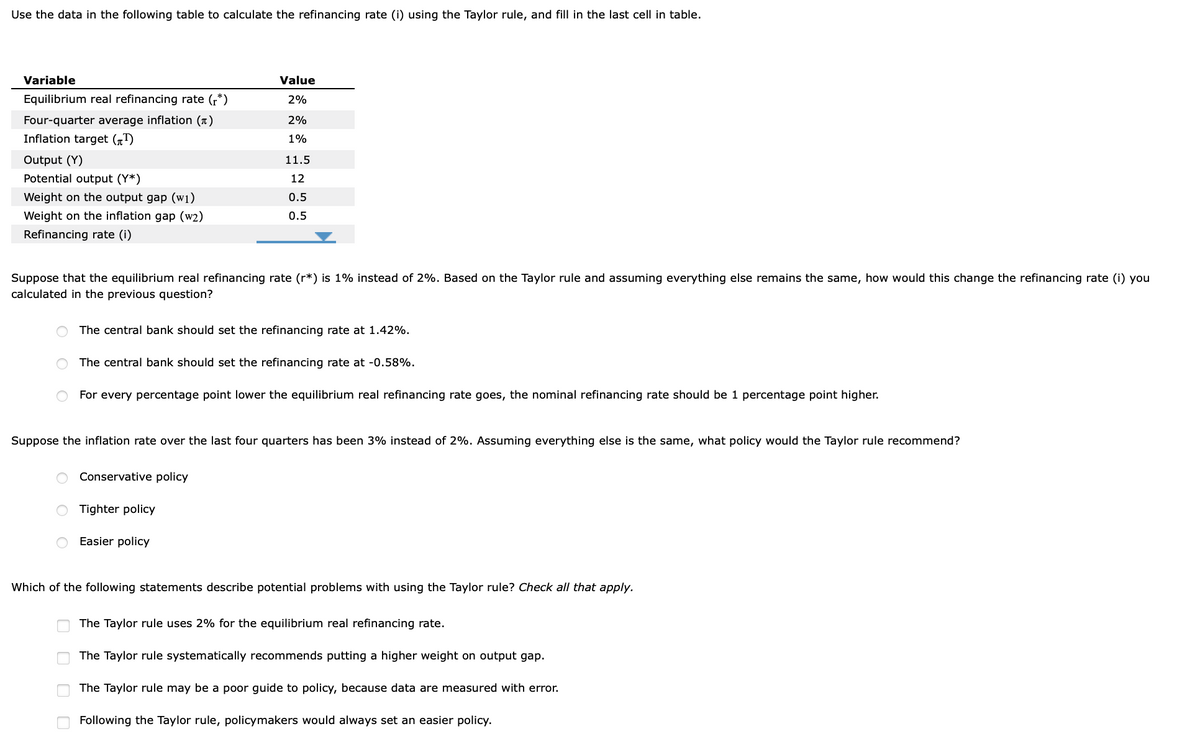Use the data in the following table to calculate the refinancing rate (1) using the Taylor rule, and fill in the last cell in table. Variable Value Equilibrium real refinancing rate (;*) 2% Four-quarter average inflation (x) 2% Inflation target (T) 1% Output (Y) Potential output (Y*) 11.5 12 Weight on the output gap (w1) Weight on the inflation gap (w2) 0.5 0.5 Refinancing rate (i) Suppose that the equilibrium real refinancing rate (r*) is 1% instead of 2%. Based on the Taylor rule and assuming everything else remains the same, how would this change the refinancing rate (i) you calculated in the previous question? The central bank should set the refinancing rate at 1.42%. The central bank should set the refinancing rate at -0.58%. For every percentage point lower the equilibrium real refinancing rate goes, the nominal refinancing rate should be 1 percentage point higher. Suppose the inflation rate over the last four quarters has been 3% instead of 2%. Assuming everything else is the same, what policy would the Taylor rule recommend? O Conservative policy O Tighter policy O Easier policy
Use the data in the following table to calculate the refinancing rate (1) using the Taylor rule, and fill in the last cell in table. Variable Value Equilibrium real refinancing rate (;*) 2% Four-quarter average inflation (x) 2% Inflation target (T) 1% Output (Y) Potential output (Y*) 11.5 12 Weight on the output gap (w1) Weight on the inflation gap (w2) 0.5 0.5 Refinancing rate (i) Suppose that the equilibrium real refinancing rate (r*) is 1% instead of 2%. Based on the Taylor rule and assuming everything else remains the same, how would this change the refinancing rate (i) you calculated in the previous question? The central bank should set the refinancing rate at 1.42%. The central bank should set the refinancing rate at -0.58%. For every percentage point lower the equilibrium real refinancing rate goes, the nominal refinancing rate should be 1 percentage point higher. Suppose the inflation rate over the last four quarters has been 3% instead of 2%. Assuming everything else is the same, what policy would the Taylor rule recommend? O Conservative policy O Tighter policy O Easier policy
Chapter1: Making Economics Decisions
Section: Chapter Questions
Problem 1QTC
Related questions
Question

Transcribed Image Text:Use the data in the following table to calculate the refinancing rate (i) using the Taylor rule, and fill in the last cell in table.
Variable
Value
Equilibrium real refinancing rate (r*)
2%
Four-quarter average inflation (1)
Inflation target („T)
2%
1%
Output (Y)
11.5
Potential output (Y*)
12
Weight on the output gap (w1)
0.5
Weight on the inflation gap (w2)
0.5
Refinancing rate (i)
Suppose that the equilibrium real refinancing rate (r*) is 1% instead of 2%. Based on the Taylor rule and assuming everything else remains the same, how would this change the refinancing rate (i) you
calculated in the previous question?
The central bank should set the refinancing rate at 1.42%.
The central bank should set the refinancing rate at -0.58%.
For every percentage point lower the equilibrium real refinancing rate goes, the nominal refinancing rate should be 1 percentage point higher.
Suppose the inflation rate over the last four quarters has been 3% instead of 2%. Assuming everything else is the same, what policy would the Taylor rule recommend?
Conservative policy
Tighter policy
O Easier policy
Which of the following statements describe potential problems with using the Taylor rule? Check all that apply.
The Taylor rule uses 2% for the equilibrium real refinancing rate.
The Taylor rule systematically recommends putting a higher weight on output gap.
The Taylor rule may be a poor guide to policy, because data are measured with error.
Following the Taylor rule, policymakers would always set an easier policy.
O O
O O
Expert Solution
This question has been solved!
Explore an expertly crafted, step-by-step solution for a thorough understanding of key concepts.
Step by step
Solved in 4 steps

Knowledge Booster
Learn more about
Need a deep-dive on the concept behind this application? Look no further. Learn more about this topic, economics and related others by exploring similar questions and additional content below.Recommended textbooks for you


Principles of Economics (12th Edition)
Economics
ISBN:
9780134078779
Author:
Karl E. Case, Ray C. Fair, Sharon E. Oster
Publisher:
PEARSON

Engineering Economy (17th Edition)
Economics
ISBN:
9780134870069
Author:
William G. Sullivan, Elin M. Wicks, C. Patrick Koelling
Publisher:
PEARSON


Principles of Economics (12th Edition)
Economics
ISBN:
9780134078779
Author:
Karl E. Case, Ray C. Fair, Sharon E. Oster
Publisher:
PEARSON

Engineering Economy (17th Edition)
Economics
ISBN:
9780134870069
Author:
William G. Sullivan, Elin M. Wicks, C. Patrick Koelling
Publisher:
PEARSON

Principles of Economics (MindTap Course List)
Economics
ISBN:
9781305585126
Author:
N. Gregory Mankiw
Publisher:
Cengage Learning

Managerial Economics: A Problem Solving Approach
Economics
ISBN:
9781337106665
Author:
Luke M. Froeb, Brian T. McCann, Michael R. Ward, Mike Shor
Publisher:
Cengage Learning

Managerial Economics & Business Strategy (Mcgraw-…
Economics
ISBN:
9781259290619
Author:
Michael Baye, Jeff Prince
Publisher:
McGraw-Hill Education